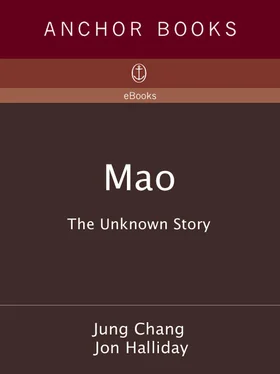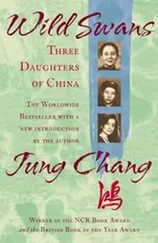Mao at once began making preparations, and his most important step was to dispatch a reliable envoy to Moscow to establish his status. (Someone had to go in person as there was no radio communication.) The man he chose had no political ambitions of his own, was obliging, and senior enough to deal with any problems that might come up in Moscow. This was Chen Yun, a member of the Secretariat. Mao chose his spokesman well. In Moscow, Chen delivered a carefully crafted message which gave the impression that the majority of the high command had elected Mao as their leader at a proper meeting: “an enlarged Politburo meeting … removed the [old] leadership and put comrade Mao Tse-tung in the leadership.”
MAO’S GROUP HAD now reached west-central Sichuan, near Tibet, marching straight north towards Chang Kuo-tao. This next stretch provided the backdrop for the primal myth about the Long March — the crossing of the bridge over the Dadu River. This river constituted a formidable natural barrier. In late May, swollen with the Himalayan snows, it was a raging torrent, trapped between towering cliffs. Its rock-strewn bed concealed treacherous whirlpools that made wading or swimming across impossible.
There was no way around, and only one bridge, which had been built in the early eighteenth century as part of the imperial road connecting Chengdu, the capital of Sichuan, to Lhasa, the capital of Tibet. It was a magnificent suspension bridge, 101 meters long and over 3 meters wide, carried by 13 thick iron chains, 9 on the bottom, with gaps a foot wide between each chain. Wooden planks paved the surface, and covered the gaps.
This bridge is the center of the Long March myth, fed to the journalist Edgar Snow in 1936. Crossing the bridge, Snow wrote, “was the most critical single incident of the Long March.” As he describes it:
half this wooden flooring had been removed [by the Nationalists], and before them [the marchers] only the bare iron chains swung to a point midway in the stream. At the northern bridgehead an enemy machine-gun nest faced them, and behind it were positions held by a regiment of White troops … [W]ho would have thought the Reds would insanely try to cross on the chains alone? But that was what they did.
He described men being shot and falling into the river.
Paraffin was thrown on the [remaining] planking, and it began to burn. By then about twenty Reds were moving forward on their hands and knees, tossing grenade after grenade into the enemy machine-gun nest.
This is complete invention. There was no battle at the Dadu Bridge. Most probably the legend was constructed because of the site itself: the chain bridge over the roiling river looked a good place for heroic deeds. There were no Nationalist troops at the bridge when the Reds arrived on 29 May. The Communists claim that the bridge was defended by a Nationalist regiment under one Li Quan-shan, but cables to and from this regiment locate it a long way away, at a place called Hualinping. There had been a different Nationalist unit headquartered in Luding, the town at one end of the bridge, but this unit had been moved out of town just before the Reds arrived. The numerous Nationalist communications make no mention of any fighting on the bridge or in the town, while they do mention skirmishes en route to the bridge, and after the Communists crossed over it. Chiang had left the passage open for the Reds.
When the Red advance unit reached the area, it set up HQ in a Catholic church near the bridge, and shelled and fired across the river at Luding on the opposite side. A local woman, who was a sprightly 93-year-old when we met her in 1997, described to us what happened. In 1935 her family — all Catholics, like most locals in those days — was running a bean-curd shop right by the bridge on the side held by the Reds, and Red soldiers were billeted in her house. She remembered the Communists firing as “Only Yin a shell, and Yang a shot”—a Chinese expression for sporadic. She did not remember her side of the river being fired on at all.
Some planks of the bridge may have been removed or damaged. The 93-year-old remembered that the Reds borrowed her doors and those of her neighbors to put on the bridge, and after the troops had crossed over, the locals went to collect their doors. But the bridge was not reduced to its bare chains: the only time this happened was when Mao’s regime made a propaganda film. Nor was the bridge set on fire. This claim was explicitly denied by the curator of the museum at the bridge in 1983.
The strongest evidence that there was no battle is that the Red Army crossed the bridge without incurring a single casualty. The vanguard consisted of twenty-two men, who, according to the myth, stormed the bridge in a suicide attack. But at a celebration immediately afterward, on June 2, all twenty-two were not only alive and well, they each received a Lenin suit, a fountain pen, a bowl and a pair of chopsticks. Not one was even wounded.
No one else died under fire. Chou En-lai’s bodyguard described how Chou, having been upset when he heard that a horse had fallen into the river, went to check on human losses. “No men lost?” Chou asked the commander of the unit that had taken the bridge, Yang Cheng-wu, to which Yang replied: “None.”
In 1982, no less an authority than China’s paramount leader, Deng Xiao-ping, himself a Dadu Bridge participant, confirmed that there was no battle. When a U.S. interlocutor described the crossing as “a great feat of arms,” Deng smiled and said, “Well, that’s the way it’s presented in our propaganda.… In fact, it was a very easy military operation. There wasn’t really much to it. The other side were just some troops of the warlord who were armed with old muskets and it really wasn’t that much of a feat, but we felt we had to dramatize it.” (Zbigniew Brzezinski, former U.S. National Security adviser, speech at Standford 2005, p. 3)
MAO WALKED ACROSS the Dadu bridge on 31 May 1935. He was now only about 300 km away from the dreaded meeting with Chang Kuo-tao. Between him and Kuo-tao’s advance unit coming to meet him was a mountain called the Big Snowy, in a largely Tibetan area. In spite of its name — and myth — there was no snow where they climbed, locals told us. But it was cold, with sleet and biting winds, made worse by the fact that many men had abandoned their warm clothes in the semi-tropical lowlands, in an effort to shed some weight. All they had to provide some warmth was boiling chili water which they drank before they set off. Although it took only one day to cross, the mountain claimed many lives, partly because of the altitude (the pass was 10,000 feet high) but mainly because the marchers had been weakened by their privations.
They had been walking virtually non-stop for nearly eight months, half the time totally pointlessly from a military or survival point of view — though not from the point of view of Mao’s ascent to power. In addition to being attacked by their enemies, they had been assailed by innumerable ailments. “All of us were unbelievably lice-ridden,” Braun remembered. “Bleeding dysentery was rampant; the first cases of typhus appeared … More and more, our route was lined with the bodies of the slain, frozen or simply exhausted.” It was hardest for those who had to carry the leaders in their litters and heavy loads. Some porters never got up again after they sat down to rest.
Mao climbed the mountain on foot, using a walking-stick. He fared far better than his young bodyguards, as he was much better nourished and rested.
Kuo-tao’s men were waiting for them on the far side, in a Tibetan town of about 100 households, with a cornucopia of supplies — not only food, but clothes, shoes, woolen socks, blankets, gloves and delicacies like preserved yellow peas, tea and salt. This army was well fed and well kitted-out, and even had supplies to spare. Mao and the other leaders got extra food, horses or donkeys, and woolen suits. A docile horse was chosen for Mao, who was also given a male doctor to serve as his nurse.
Читать дальше










